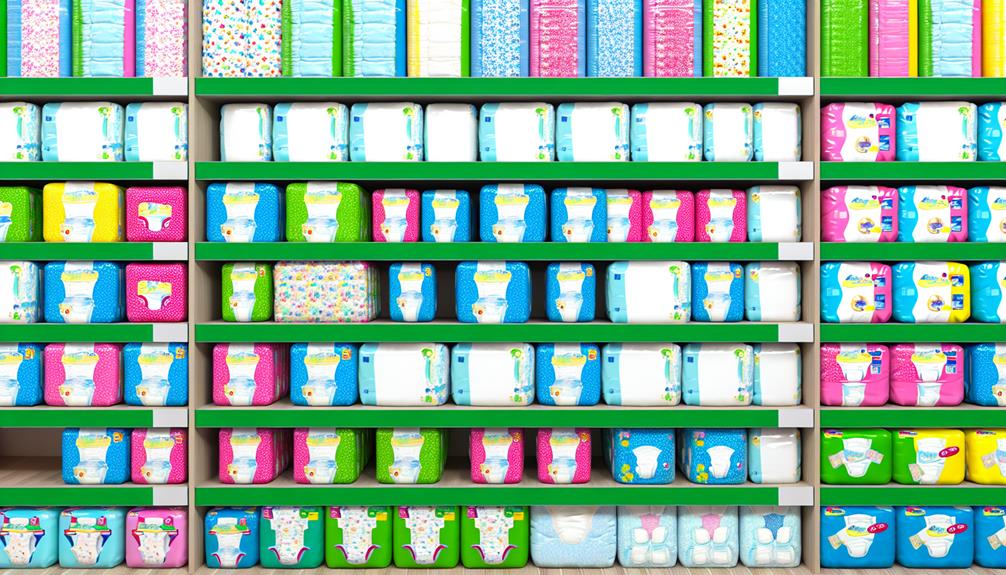When it comes to parenting, the diaper symbolizes a fundamental aspect of caring for your little one. However, have you ever wondered about the intricate details that make up the world of disposable diapers? From unraveling the history behind their invention to navigating the vast array of options available today, there’s a wealth of information waiting to be discovered. Find out how these everyday essentials have evolved to meet the needs of modern parents and uncover valuable insights that can make your diapering journey a breeze.
Key Takeaways
- Consider disposable diaper size based on weight for proper fit.
- Explore various types like overnight, sensitive skin, or eco-friendly options.
- Maximize savings by purchasing in bulk or using coupons.
- Understand the pros and cons of disposable diapers for informed decisions.
- Follow diapering tips for new parents to ensure their baby’s comfort and hygiene.
History of Disposable Diapers
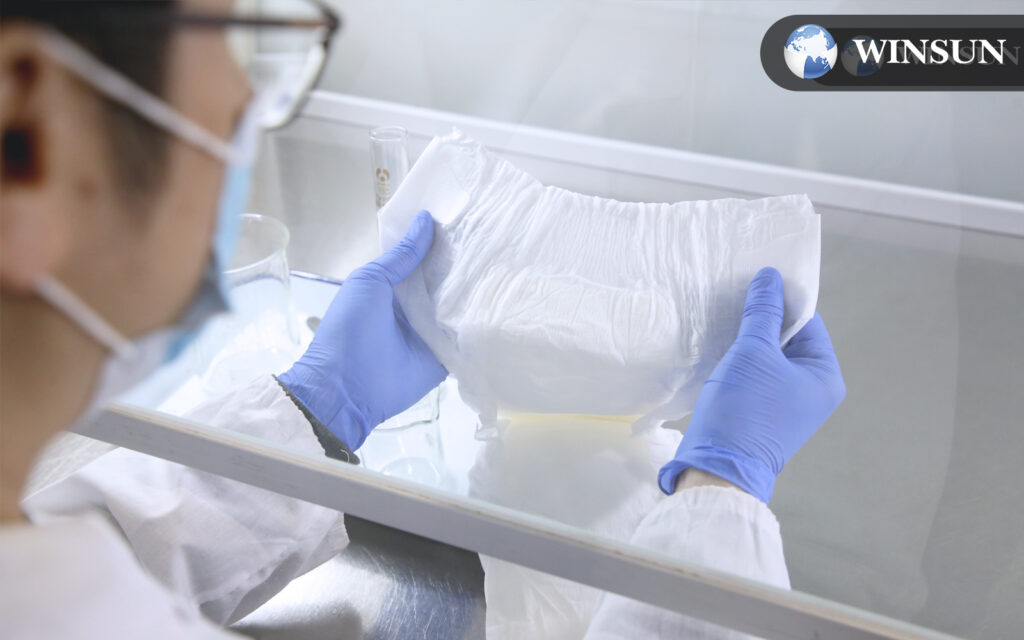
The journey of disposable diapers is a tale of innovation and convenience, marking a significant shift in parenting practices worldwide. To truly understand their evolution, we must journey back to their inception and trace the path of development that has led to the modern-day convenience we know.
In the early 20th century, cloth diapers dominated the scene, requiring frequent washing and drying—a time-consuming and labor-intensive process for parents. However, the landscape changed dramatically in 1942 when Marion Donovan, a mother frustrated with the inconvenience of cloth diapers, introduced the first prototype of the disposable diaper. Made from a moisture-resistant material called “boater,” Donovan’s invention laid the foundation for a revolution in baby care.
Fast forward to the 1960s, and the disposable diaper industry began to take shape with the introduction of brands like Pampers and Luvs. These early iterations featured improvements in absorbency and fit, making them more practical for everyday use. As demand surged, manufacturers refined their designs, incorporating elastic leg gathers, adhesive tabs, and breathable materials for enhanced comfort and leak protection.
The 1980s marked a turning point with the introduction of superabsorbent polymers (SAPs), revolutionizing diaper performance by significantly increasing absorbency while reducing bulk. This innovation paved the way for thinner, more efficient diapers that could keep babies drier for longer periods.
In the ensuing decades, the disposable diaper industry continued to evolve, with manufacturers focusing on sustainability, eco-friendly materials, and biodegradability. Today, parents have access to an extensive array of disposable diaper options, each catering to specific needs and preferences, from overnight protection to sensitive skin care.
Facts and Figures About Disposable Diapers
As you consider the impact of disposable diapers on the environment and economy, understanding the facts and figures surrounding their usage becomes imperative. Disposable diapers are the third-largest single consumer item in landfills, making up about 4% of solid waste. According to the EPA report, they take at least 500 years to decompose fully, emitting toxic gases during degradation. The disposal challenges are significant, with over 20 billion used diapers ending up in landfills annually.
The economic impact is substantial, with the disposable diaper industry being a $71 billion-a-year industry. Additionally, 95% of U.S. mothers solely use disposable diapers for their children, with 1 in 3 mothers cutting back on essentials to afford them. Diaper costs can amount to 2% of American mothers’ total household income, showing the financial challenges families face.
These figures highlight both the environmental consequences and financial burdens associated with disposable diaper usage, encouraging a more informed decision-making process regarding their use.
Recommended: Disposable Nappies Facts You Need to Know
Choosing the Right Disposable Diaper Size

Selecting the correct size of a disposable diaper is crucial for ensuring your baby stays comfortable and dry throughout the day. The right fit not only prevents leaks but also helps maintain your little one’s skin health. Here’s a step-by-step guide to help you choose the perfect diaper size for your baby:
- Refer to the Diaper Size Chart: Most diaper brands provide a size chart based on weight ranges. Refer to this chart to determine which size is suitable for your baby’s current weight.
- Newborn Size: For babies weighing between 6 to 10 pounds, newborn-sized diapers are typically the best fit. These diapers are specially designed to accommodate the needs of newborns, offering a snug and comfortable fit.
- Small Size: As your baby grows, you may transition to small-sized diapers, which are suitable for babies weighing between 8 to 14 pounds. These diapers provide ample coverage and protection for infants in the early months.
- Medium Size: Many babies wear medium-sized diapers for an extended period, as they offer a balance between snugness and room to move. Most babies transition to medium-sized diapers after outgrowing the small size. However, individual growth rates vary, so monitor your baby’s fit closely.
- Large Size: Around 8 months or when your baby reaches a weight of 20 pounds or more, you may consider transitioning to large-sized diapers. These diapers provide enhanced coverage and absorbency, catering to the needs of growing babies.
- Observe Signs of Fit: Pay attention to signs that indicate it’s time to move up a diaper size. If you notice frequent leaks, red marks on your baby’s skin, or if the diaper feels too snug, it may be time to switch to a larger size.
- Trust Your Instincts: Every baby is unique, so trust your instincts as a parent. If you’re unsure about the best diaper size for your baby, don’t hesitate to seek assistance from your pediatrician or a knowledgeable caregiver.
Diaper Size Chart
| Diaper Size | Weight Range |
|---|---|
| Preemie | Up to 6 lbs |
| Newborn | Up to 10 lbs |
| Size 1 | 8 – 14 lbs |
| Size 2 | 12 – 18 lbs |
| Size 3 | 16 – 28 lbs |
| Size 4 | 22 – 37 lbs |
| Size 5 | 27 – 35 lbs |
| Size 6 | 35 lbs and over |
| Size 7 | 41 lbs and over |
Please note that these weight ranges are approximate and may vary slightly between different diaper brands. It’s essential to consider your baby’s body type and try out different brands and sizes to find the best fit.
Choosing the right disposable diaper size is essential for your baby’s comfort and well-being. By referring to size charts, observing signs of fit, and trusting your instincts, you can ensure your little one stays dry and happy throughout their diapering journey.
Recommended: Disposable Nappy Fit Guide
Pros and Cons of Disposable Diapers
When considering whether to use disposable diapers, it’s essential to weigh the advantages and disadvantages to make an informed decision for your baby’s care.
- Quick and convenient diaper-changing process
- One-time use eliminates the need for cleaning and washing
- Ideal for parents with limited time and busy schedules
- Potentially more sanitary as waste can be easily disposed of
However, there are drawbacks to using disposable diapers. They can be costly, contributing to environmental waste and potentially irritating for babies with sensitive skin. Some babies may develop skin rashes due to the materials in disposable diapers.
To address environmental concerns, biodegradable disposable diapers offer a more eco-friendly option, although they may require additional effort and cost. Parents can also consider reusable cloth diapers as a sustainable alternative to reduce plastic waste.
Remember to monitor your baby’s skin for any signs of irritation and choose the option that best suits your lifestyle and values.
Exploring Different Types of Disposable Diapers
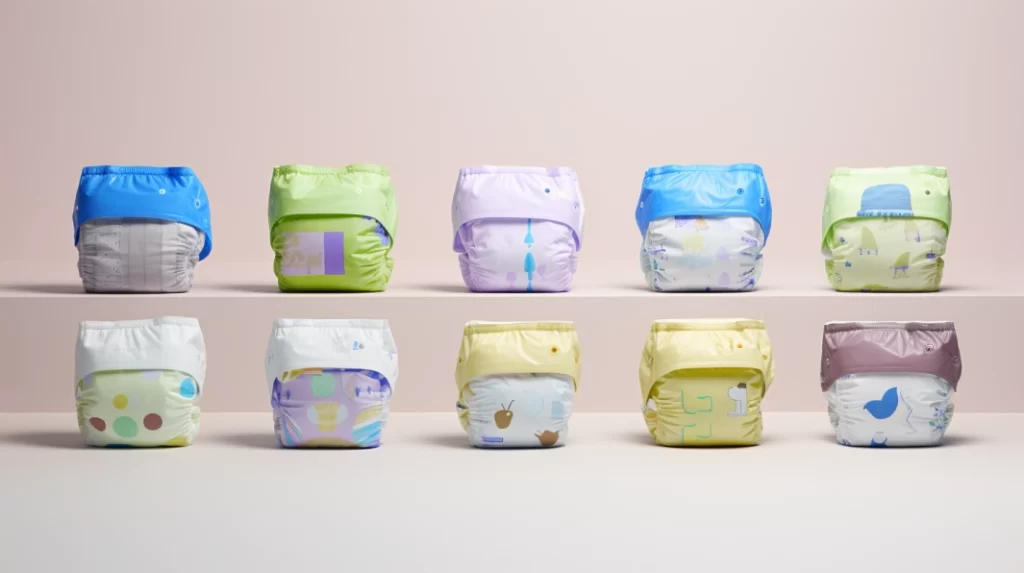
Considering the diverse range of disposable diaper options available in the market, navigating through the various types can help you find the best fit for your baby’s needs and preferences.
Standard Disposable Diapers are the most common choice for everyday use, while Overnight Disposable Diapers offer extra absorbency for overnight wear.
Sensitive Skin Disposable Diapers cater to babies with delicate skin, being hypoallergenic and free of irritants. Eco-Friendly Disposable Diapers are sustainable and environmentally friendly.
Pull-up disposable Diapers are ideal for toddlers transitioning to underwear, featuring tear-away sides for easy removal. Diapers for Preemies offer a snug fit for premature babies, and Diapers for Active Babies accommodate little ones on the move.
Diapers with Wetness Indicators make changing easier, and those with Umbilical Cord Cut-Outs are gentle on newborns. Gender-specific diapers are tailored to boys or girls.
Understanding the different types of disposable nappies helps when selecting the right fit for your baby. If you’re interested in disposable training pants or looking to bulk-buy disposable nappies wholesale, exploring the diverse options available will ensure you make the best choice.
Disposable Swim Diapers
Disposable swim diapers are essential for ensuring a worry-free and enjoyable pool or beach experience with your little one. When choosing the right swim diapers, keep in mind their functionality and comfort. Here are some essential tips to consider:
- Snug Fit: Ensure the swim diaper fits snugly to prevent any leaks in the water.
- Quality Material: Opt for swim diapers made from high-quality, waterproof materials to ensure they hold up well in water.
- Cute Designs: Look for swim diapers with cute designs that your child will love wearing.
- Trusted Brands: Consider purchasing swim diapers from reputable manufacturers like a disposable baby diapers manufacturer in China for quality assurance.
Related: Best Disposable Swim Diapers for Infants
Biodegradable Disposable Diapers
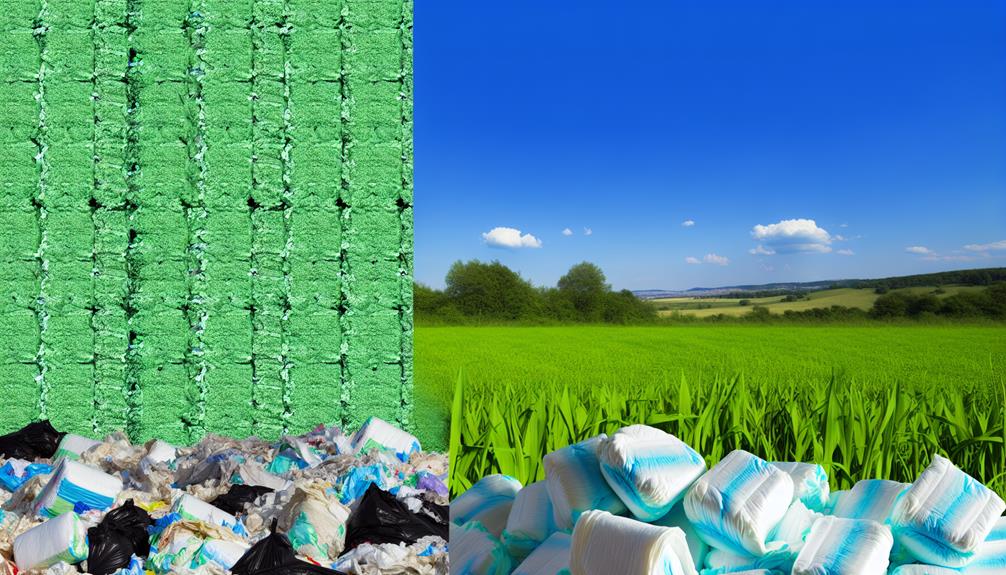
Choosing biodegradable disposable diapers for your baby’s needs can help reduce environmental impact while providing the convenience and performance you expect. Made from sustainable materials that break down more easily than traditional disposable diapers, biodegradable options are a great eco-friendly choice for parents looking to minimize their carbon footprint. These diapers are free from harmful chemicals, making them gentle on your baby’s sensitive skin. They offer excellent absorbency and leakage protection, ensuring your little one stays dry and comfortable.
When disposing of biodegradable diapers, you can feel good knowing that they’ll decompose more quickly than regular diapers, reducing the amount of waste that ends up in landfills. While they may cost slightly more than conventional diapers, the environmental benefits they offer are significant. By choosing biodegradable disposable diapers, you aren’t only prioritizing your baby’s well-being but also making a positive impact on the planet for future generations.
Finding the Best Deals on Disposable Diapers
When seeking the best deals on disposable diapers, your budget-conscious approach can lead to significant savings without compromising on quality or performance. To help you make the most cost-effective choices, consider the following tips:
- Subscribe and Save: Many online retailers offer subscription services that provide discounts on recurring diaper purchases. Subscribing can’t only save you money but also ensure you never run out of diapers.
- Bulk Buys: Purchasing diapers in bulk quantities often result in lower per-unit costs. Look for special deals on larger packs to maximize your savings.
- Coupon Clipping: Keep an eye out for diaper coupons in newspapers, online platforms, or through loyalty programs. Using coupons can significantly reduce your diaper expenses.
- Store Discounts: Take advantage of store promotions, sales, and loyalty programs to get the best deals on disposable diapers. Some stores offer discounts for buying in multiples or during special events.
Recommended:
- The Ultimate Guide to Finding the Cheapest Disposable Nappies
- Diaper Price: Disposable Diapers vs Cloth Diapers Options
Disposable Diapers vs. Cloth Diapers
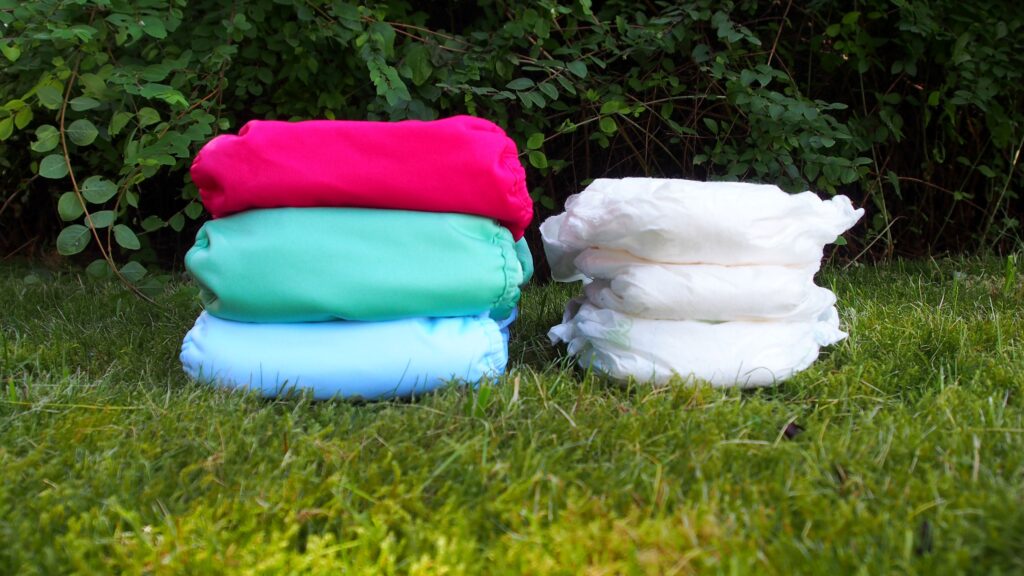
Opting for cloth diapers over disposables can be a sustainable and cost-effective choice for many parents. While disposable diapers offer convenience, cloth diapers present several advantages worth considering.
Cloth diapers are reusable, reducing the environmental impact of diaper waste. They’re often made from natural fibers, which can be gentler on your baby’s skin and reduce the risk of irritation. Additionally, cloth diapers can save you money in the long run, especially if you plan to have multiple children or use them for an extended period.
When comparing the two options, it’s essential to consider factors such as washing routines, upfront costs, and environmental concerns. Cloth diapers require more effort in terms of washing and maintenance, but many parents find the benefits outweigh the extra work. Disposable diapers, on the other hand, offer convenience but come with a higher overall cost and contribute significantly to landfill waste.
Ultimately, the decision between cloth and disposable diapers depends on your family’s needs and values. Both options have their pros and cons, so weigh them carefully to make the choice that aligns best with your lifestyle and priorities.
Manufacturing Disposable Diapers in China
Considering your interest in the environmental impact of diaper choices, exploring the manufacturing process of disposable diapers in China can offer valuable insights into the production practices and supply chain of these widely used baby products.
Winsun Diapers: Leading the Way in Sustainable Manufacturing
Winsun, a prominent diaper manufacturer based in China, is committed to sustainable production practices and environmental responsibility. With state-of-the-art facilities and a focus on innovation, Winsun leads the industry in creating high-quality disposable diapers while minimizing ecological impact.
Here are some key points to consider about the manufacturing of disposable diapers in China:
- Efficient Production: Chinese factories often utilize advanced machinery to efficiently produce disposable diapers in large quantities.
- Supply Chain Management: Manufacturers in China have well-established supply chains to source materials such as superabsorbent polymers and non-woven fabrics.
- Quality Control Measures: Stringent quality control measures are implemented during the manufacturing process to ensure that the diapers meet safety and performance standards.
- Environmental Impact: Winsun Diapers, along with other manufacturers, are increasingly focusing on sustainable practices, such as recycling production waste and reducing energy consumption.
Understanding how disposable diapers are manufactured in China can provide insights into the industry practices and the efforts being made to address environmental concerns while meeting the high demand for these products.
Interested in learning more about Winsun Diapers or have specific inquiries? Contact us today for personalized assistance!
Diapering Tips for New Parents
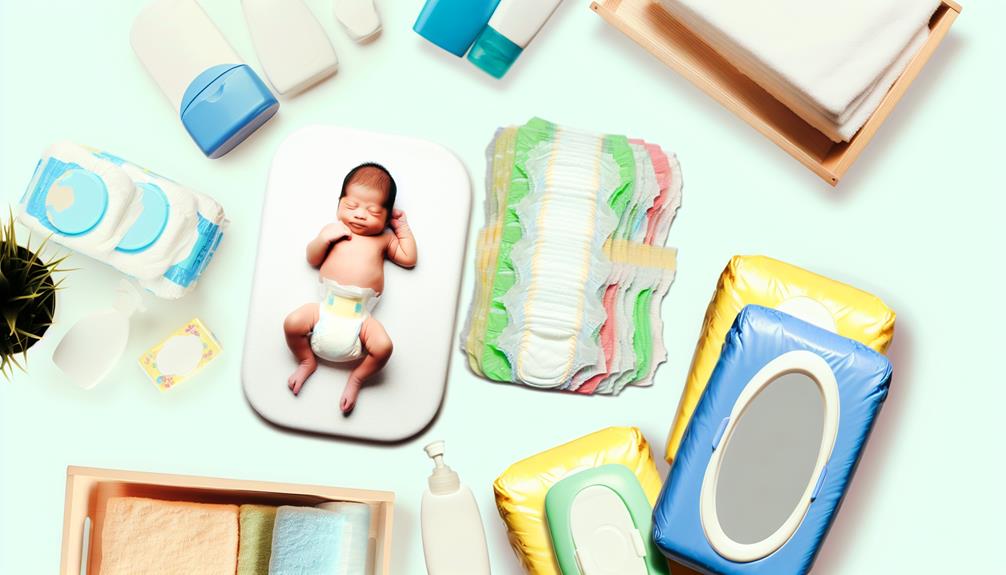
For new parents, mastering the art of diapering is a crucial skill for ensuring your baby’s comfort and hygiene. Here are some diapering tips to help you navigate through this essential task with ease:
- Be Prepared: Before you start changing your baby’s diaper, make sure you have all the necessary supplies within reach. This includes clean diapers, wipes, diaper rash cream, and a changing pad.
- Choose the Right Size: Using the correct diaper size is key to prevent leaks and ensure your baby stays comfortable. Check the weight and age recommendations on the diaper packaging to find the best fit.
- Proper Technique: When changing a diaper, clean your baby’s diaper area thoroughly with wipes and pat it dry before putting on a fresh diaper. Make sure the diaper fits snugly but not too tight to avoid leakage.
- Diaper Rash Prevention: To prevent diaper rash, change your baby’s diaper frequently, give some diaper-free time, and apply a thin layer of diaper rash cream as needed.
Frequently Asked Questions
Are Disposable Diapers Safe for Babies With Sensitive Skin?
Disposable diapers can be safe for babies with sensitive skin. Look for hypoallergenic options with gentle materials. Change diapers frequently, use diaper cream as needed, and monitor for any signs of irritation. Consult your pediatrician for personalized advice.
Can Disposable Diapers Be Composted or Recycled?
Yes, disposable diapers can be composted in specific composting facilities designed for biodegradable materials. Check with your local waste management to see if they accept them. Recycling options are limited due to the mix of materials.
How Do Disposable Diapers Impact the Environment Long-Term?
Disposable diapers have a significant long-term impact on the environment due to slow decomposition and harmful chemicals. They contribute to landfill waste and require resources for production. Consider eco-friendly alternatives like cloth diapers to lessen this impact.
Are There Disposable Diapers Specifically for Overnight Use?
Yes, there are disposable diapers designed specifically for overnight use. These diapers offer extra absorbency to keep your baby dry and comfortable throughout the night. They provide reliable protection, helping both you and your little one sleep better.
Do Disposable Diapers Have an Expiration Date?
Disposable diapers don’t have a strict expiration date, but they do have a shelf life of about 2-3 years. Over time, the materials can break down, affecting absorbency. For optimal performance, store them in a cool, dry place.
Conclusion
As you navigate the vast world of disposable diapers, it’s essential to remain mindful of the significant environmental impact they pose. With approximately 27.4 billion disposable diapers used worldwide every day, the need for sustainable diapering solutions has never been more pressing.
But fear not, for you hold the power to make a positive difference for the planet and your baby’s future. By making informed choices and considering alternatives like cloth diapers, you can reduce your ecological footprint while providing your little one with the care they deserve.
Ready to take the next step towards a greener future for your baby? Explore eco-friendly diapering options from Winsun Diapers today! Our commitment to sustainability ensures that you can make choices that benefit both your family and the environment.
Stay informed, stay empowered, and make the best decisions for your little one’s comfort and the well-being of our planet.
Read more: The Complete Guide to Disposable Diapers
